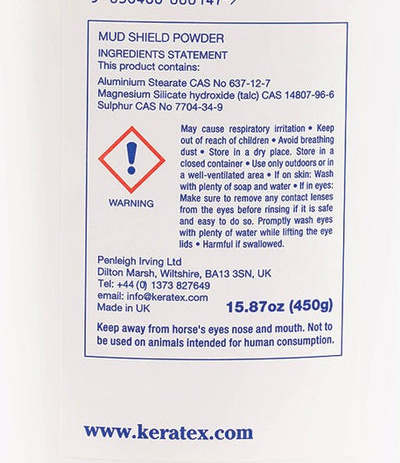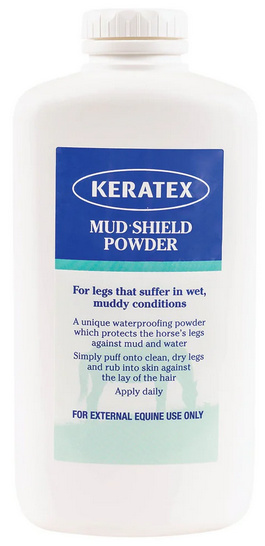note: Diet contains plenty of Zinc and Copper!
My special little cupcake threw a first case at me this year for reasons. And of course, see “special little cupcake” reacted to just about everything I tried to clear it up. Anyway, we’re finally getting on top of this nonsense now (baby ass cream + tetracycline powder + keeping it wrapped FTW) so I’m thinking forward to prevention during mud season which could last all winter since we don’t seem to get the cold and snow we used to get anymore.
I’ve found a couple of products available, Keratex Mud Shield Powder and Dust On! Skin Powder. Has anyone used either or any other product and been happy with the results?

Description
Keratex Mud Shield Powder is a highly-acclaimed, handy, easy-to-use powder for horse’s legs. Mud Shield powder creates a cleansing and waterproofing action on legs which are prone to scabs and broken skin in wet and muddy conditions. This light talc will give your horse’s legs a breathable, resilient coat of powder that does not absorb water and does not become sticky. It also works by making the leg hair so silky that mud cannot grip onto hair or soften the skin underneath. This respected product is widely recognized by the equestrian community as a leader in its field. Available in an easy-to-use puff bottle. Topical powder. 450gm.
Easy-to-use powder for horse’s legs
Creates a cleansing and waterproofing action on legs which are prone to scabs and broken skin
For use in wet and muddy conditions
Creates a breathable, resilient coat of powder that does not absorb water or become sticky
Makes leg hair silky so mud cannot grip onto hair or soften the skin underneath
Puff bottle
Topical powder
450gm
Dust On! All-In-One Wound Dressing is a dry powder that stops bleeding fast. Draws and absorbs discharge. Creates a firm and breathable scab. Allows body to heal naturally and does not damage live tissue. Non-caustic for proud flesh. Also for dehorning/docking. All-natural; for all animals. Contains multiple clays as the light base that draws, absorbs and adheres; 13% food grade copper salt/active; diatomaceous earth and oregano powder. Directions: Before first use, gently cleanse affected area and remove all debris. Puff powder directly on and around laceration, abrasion or rash. Use 1-3 times a day until bleeding and drainage ceases. Once per day thereafter. When scab size has considerably decreased, continue use 2-3 time per week to aid against proud flesh. Made in the USA. 2.5oz / 70.9g
*truly wet summer + longer grass than usual + some potentially not clean fill added to pasture right by the gate + some potentially sketch footing (we’ve moved, but are now in MudVille lol)




 no, she is warmblood.
no, she is warmblood. 
